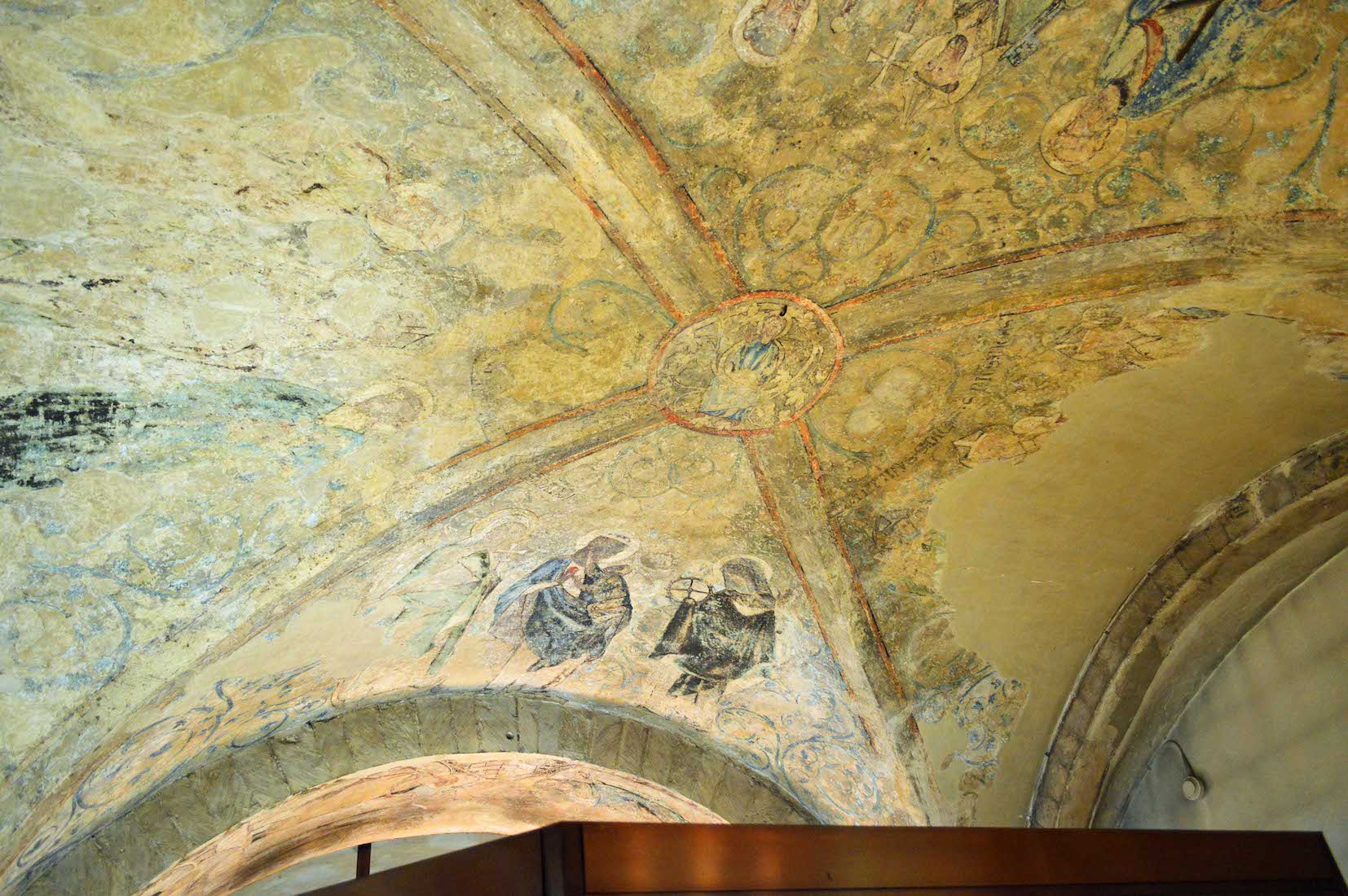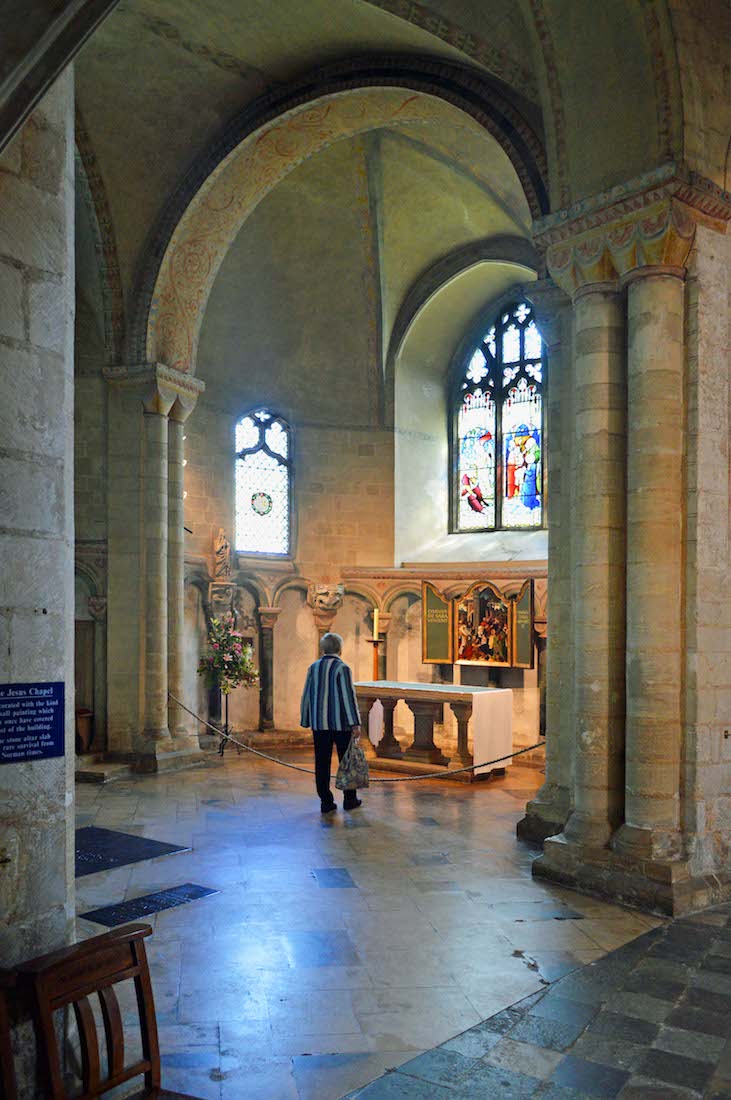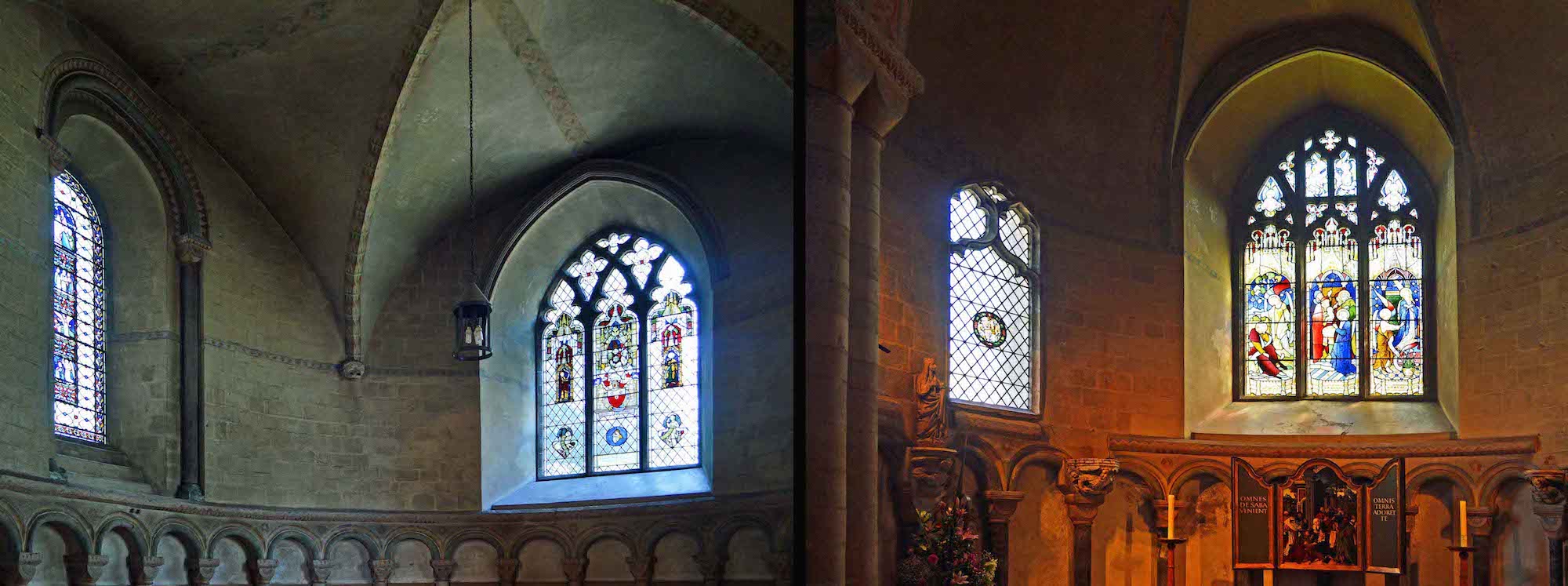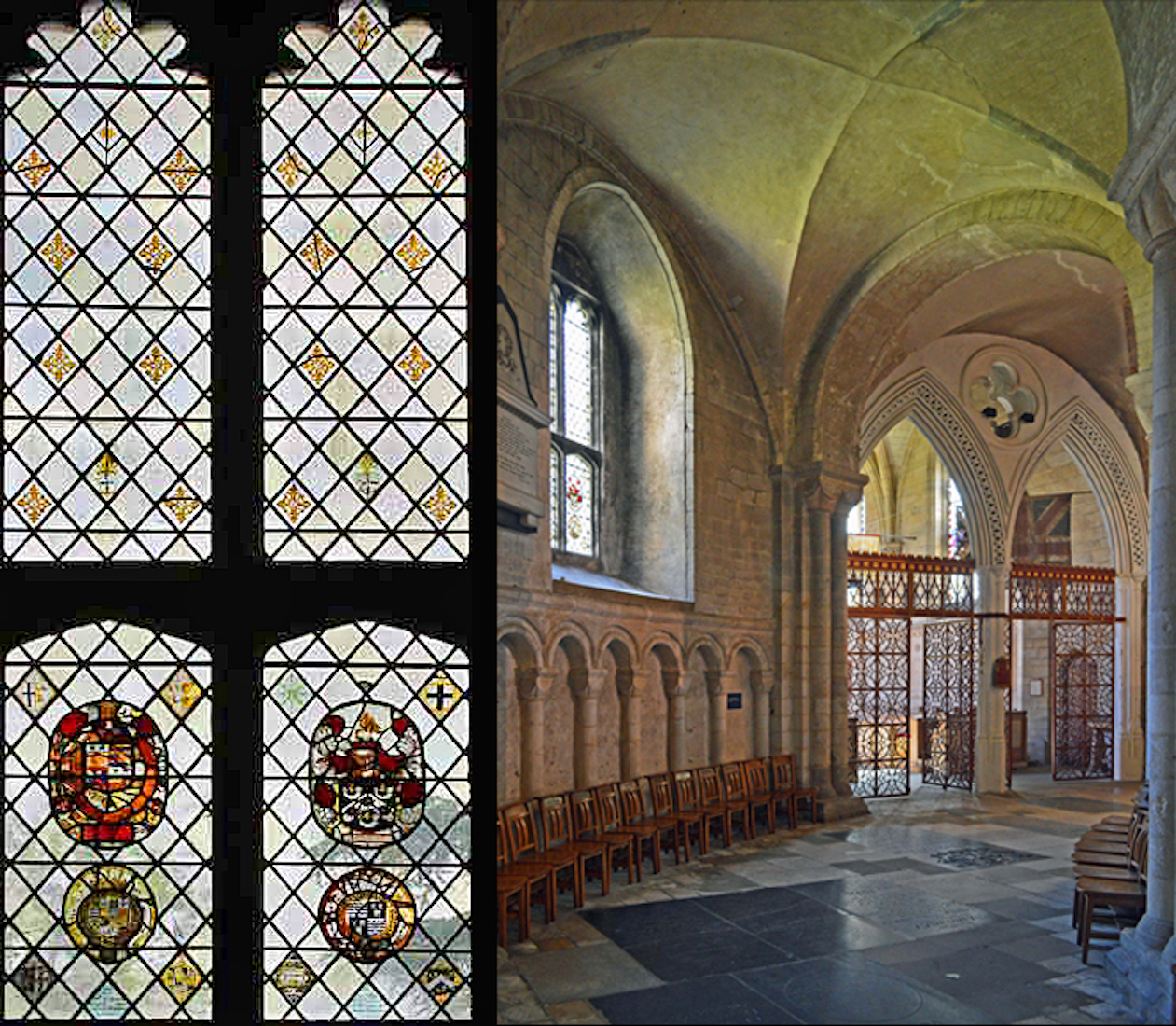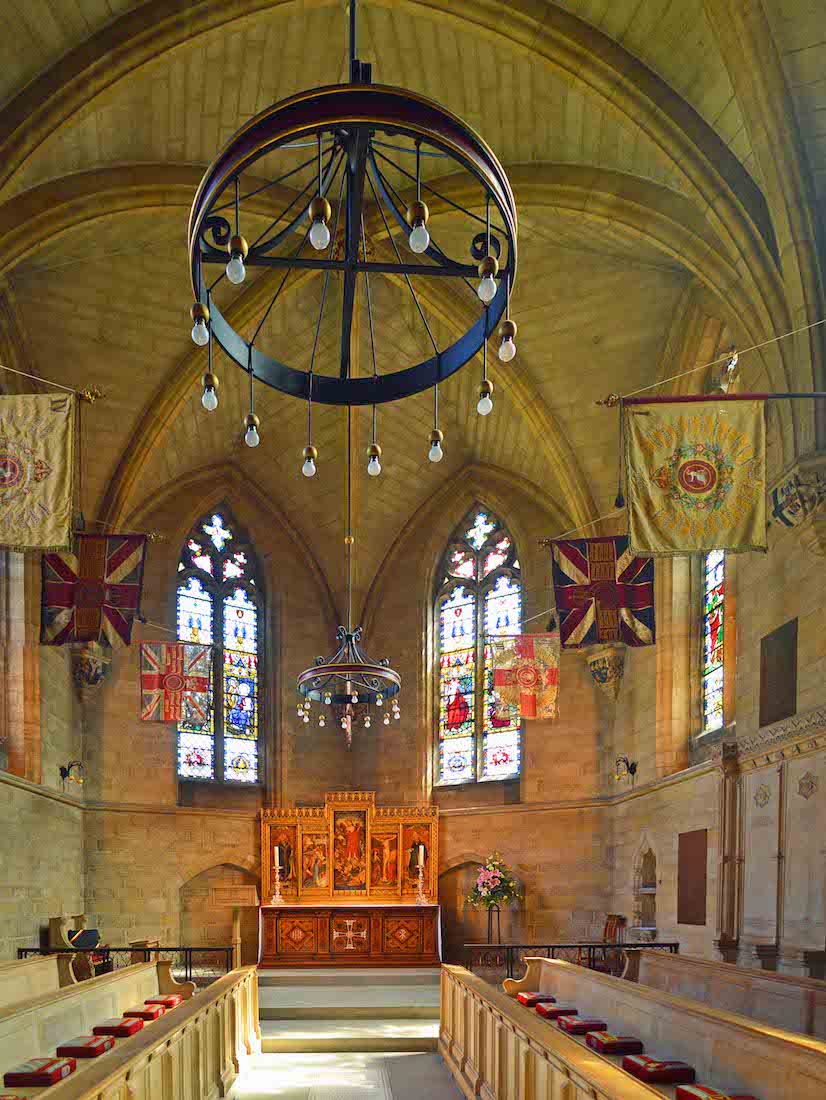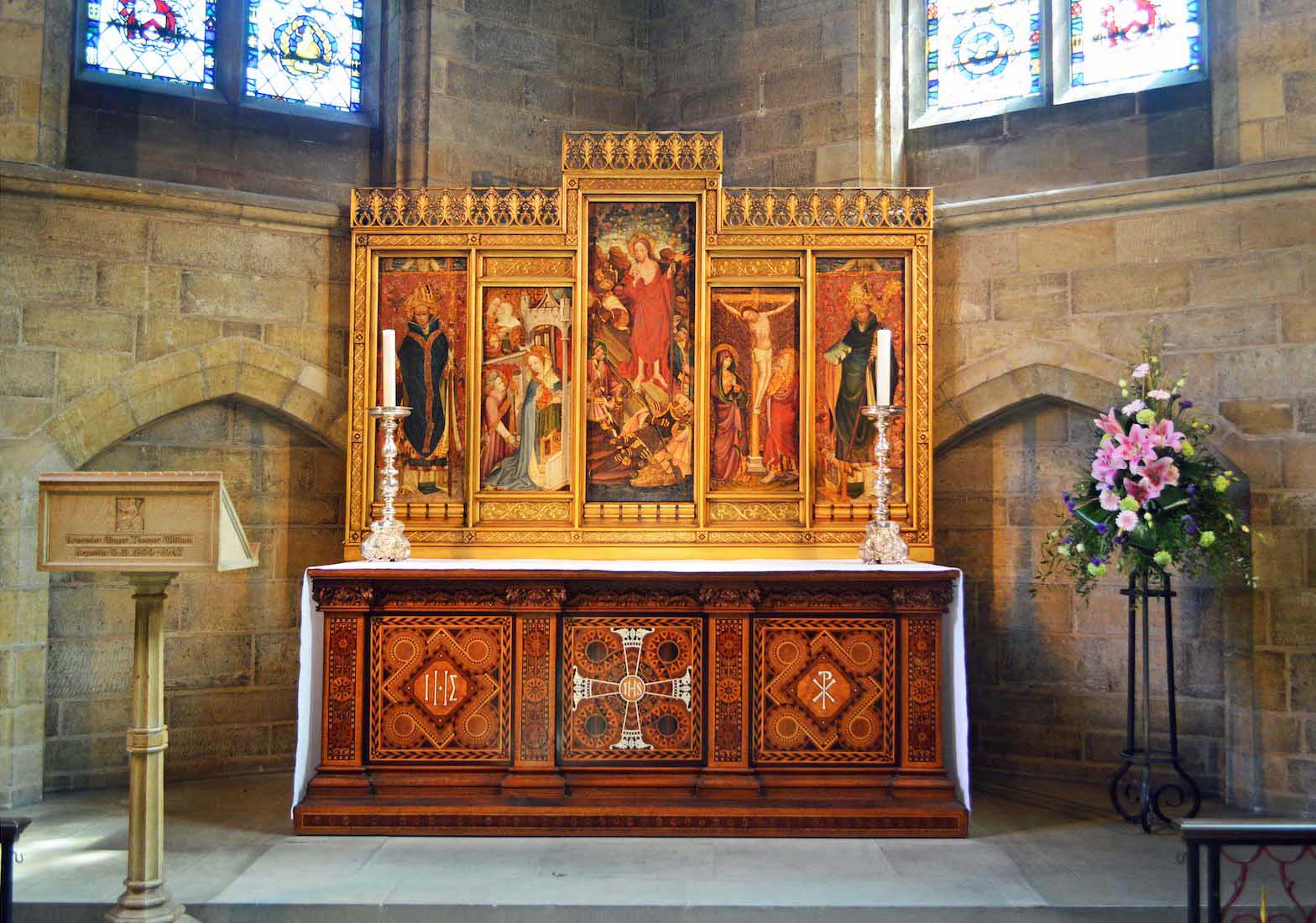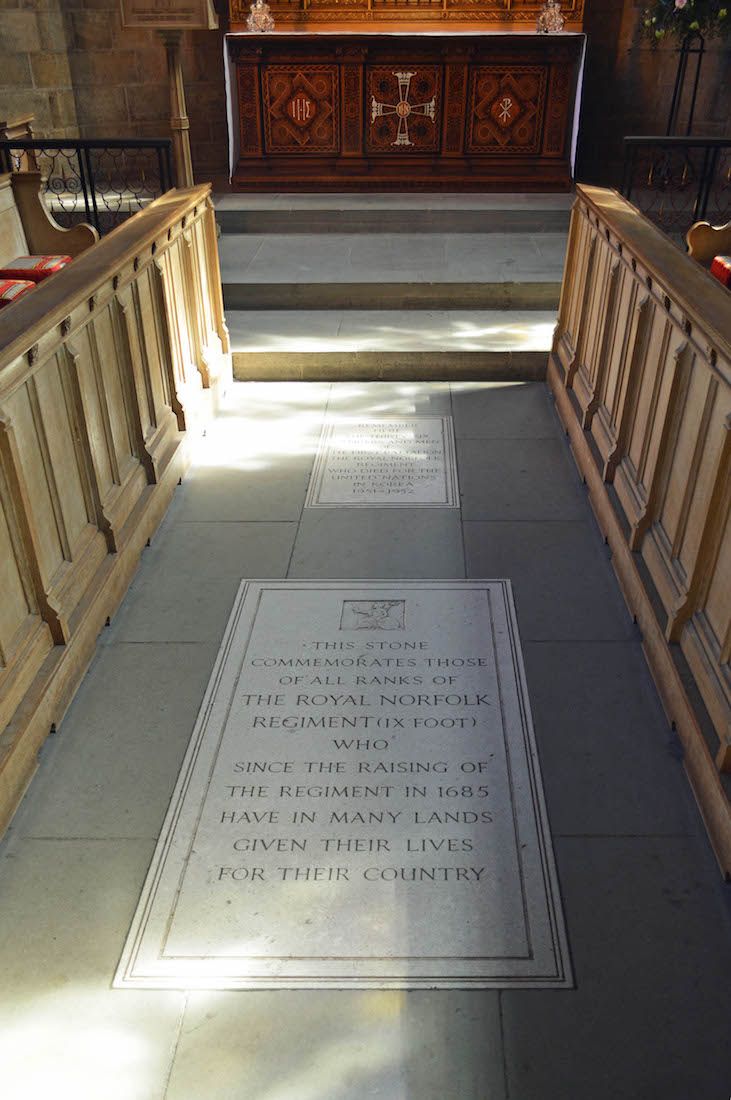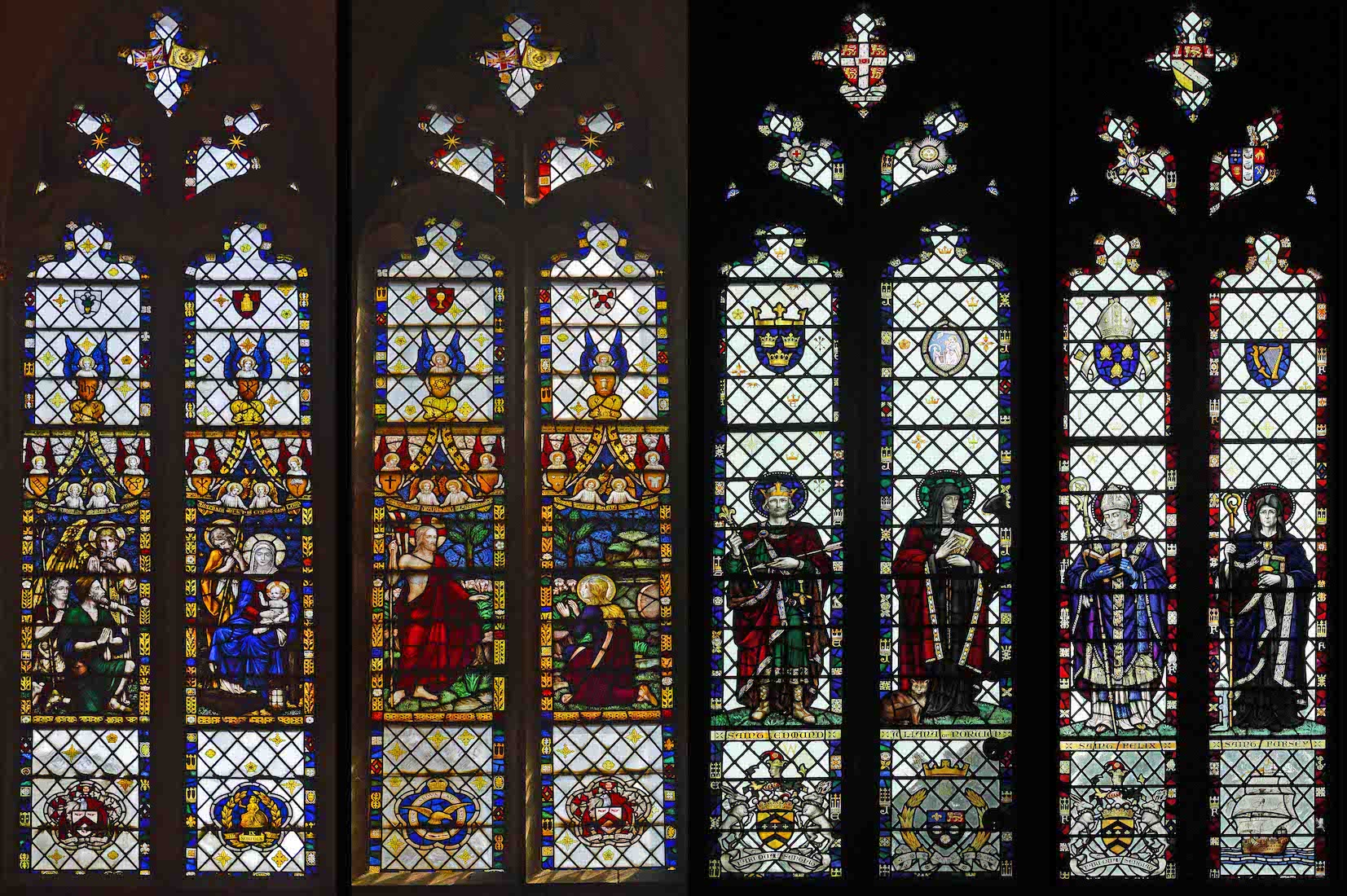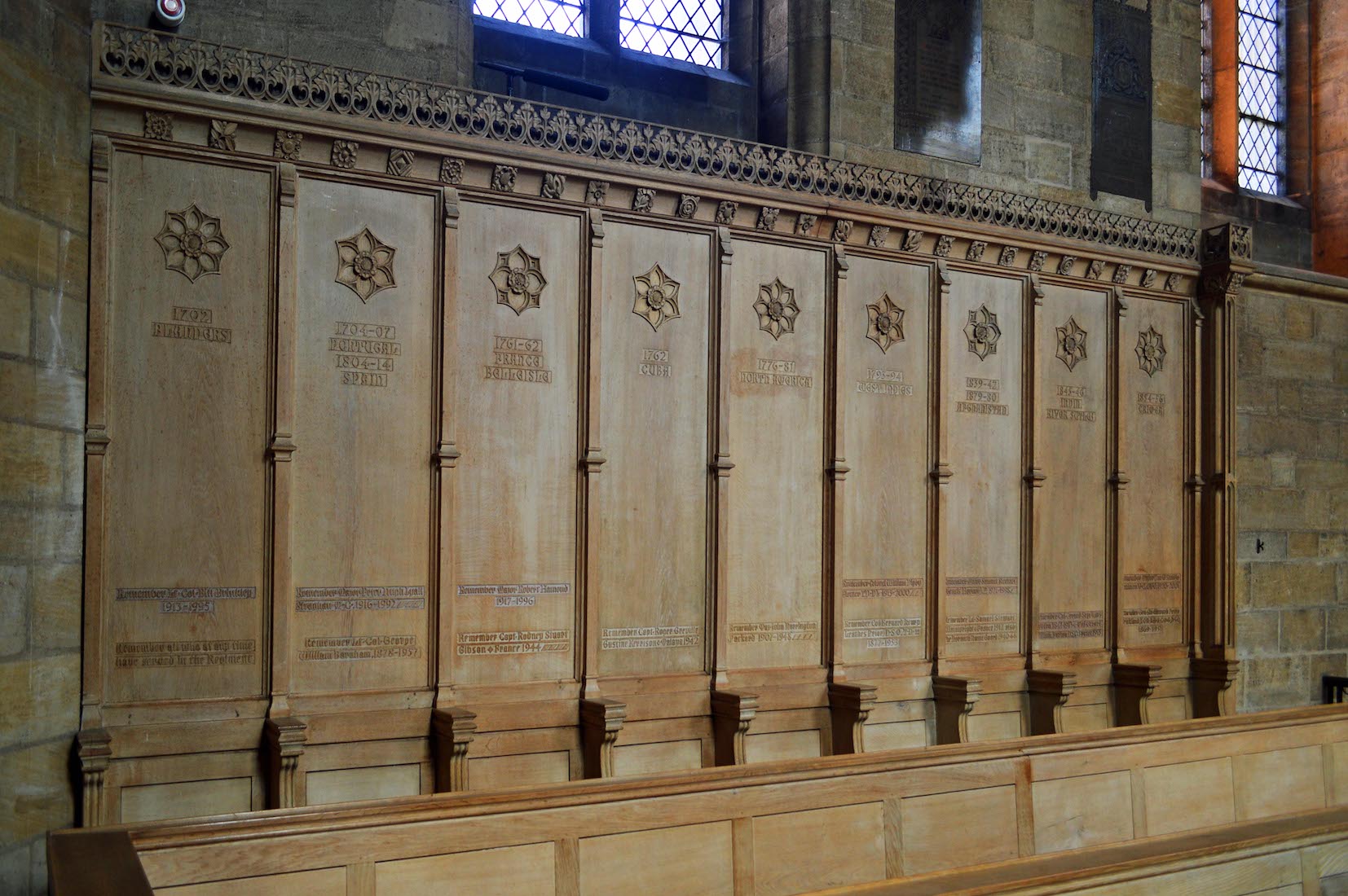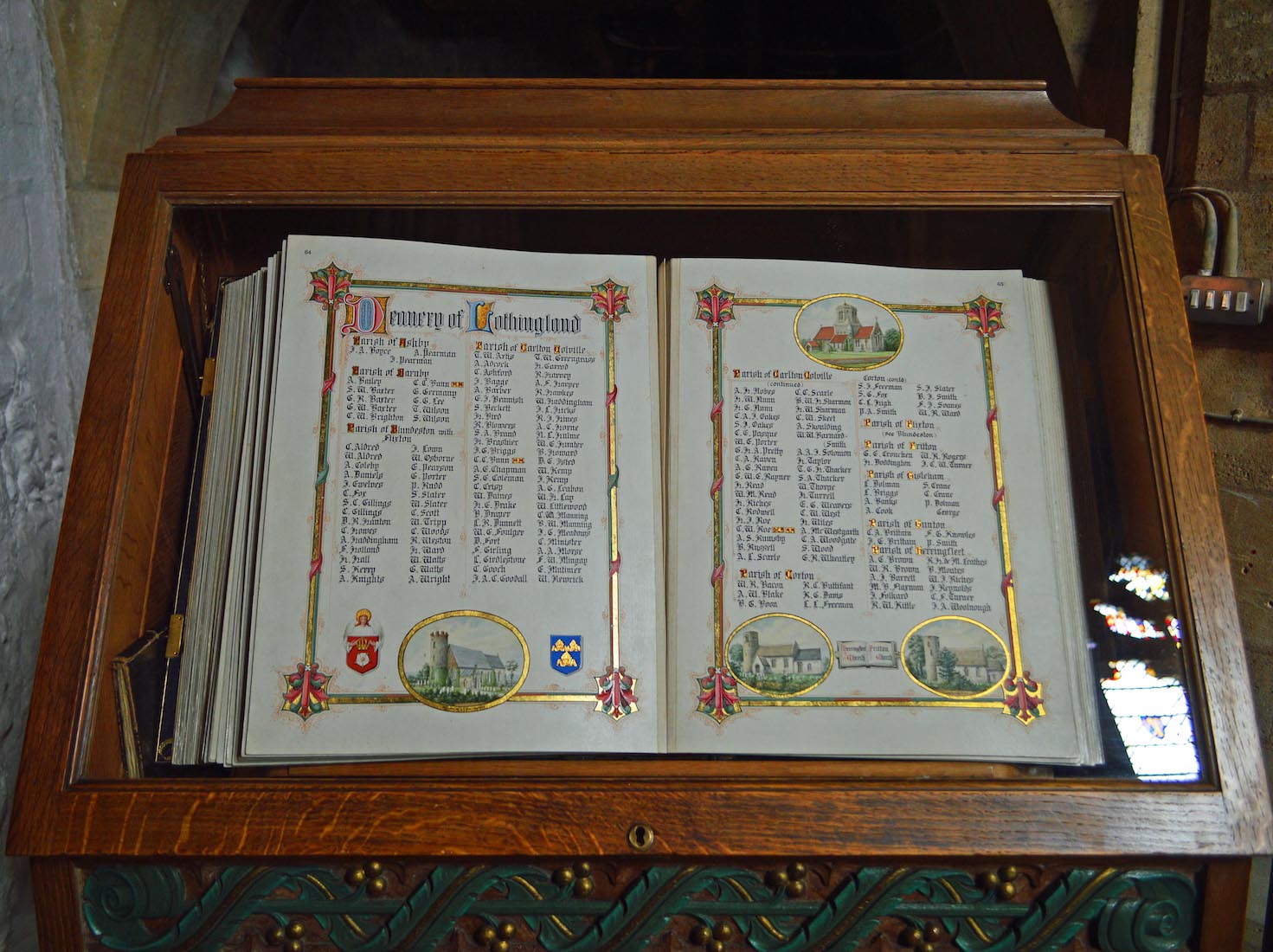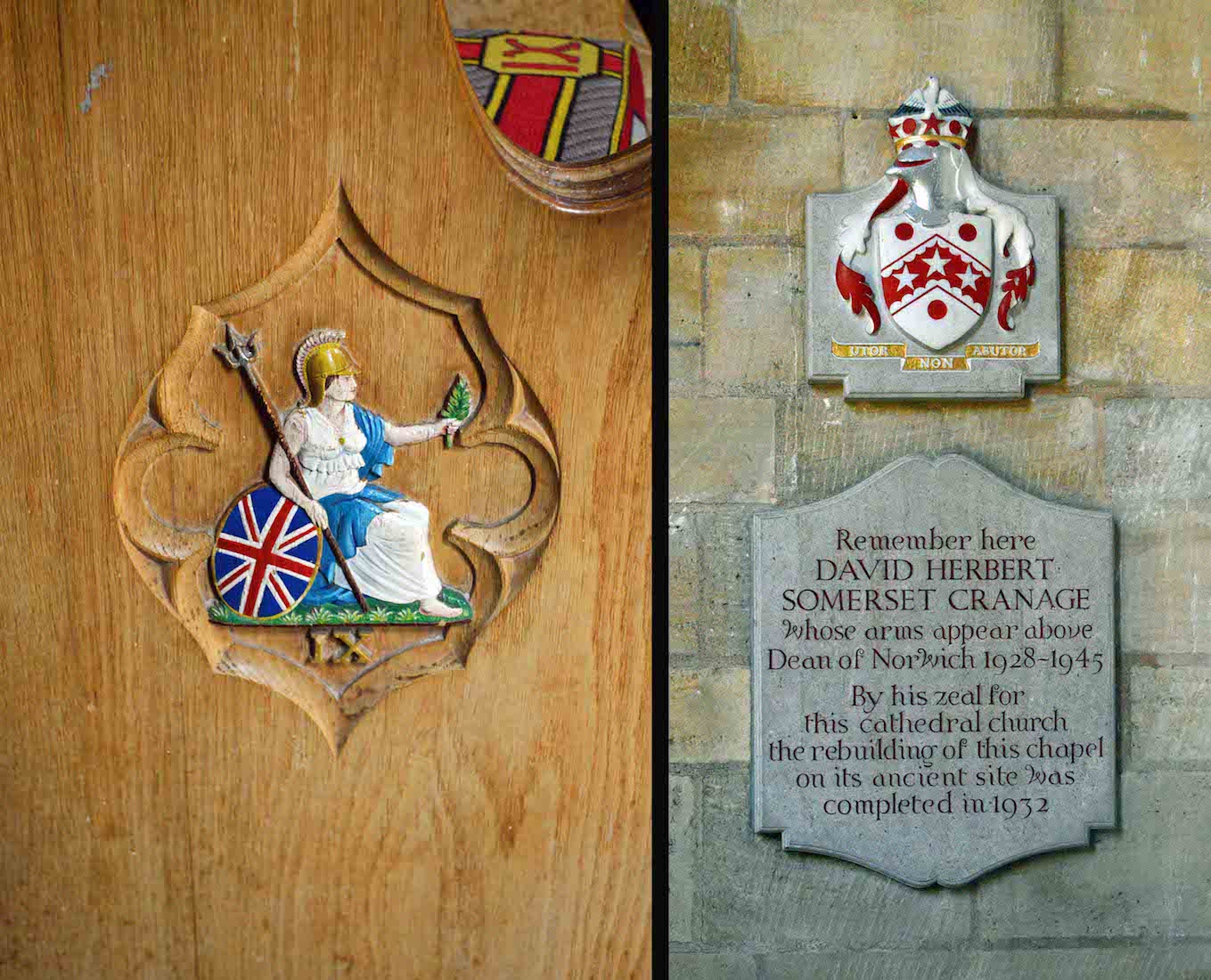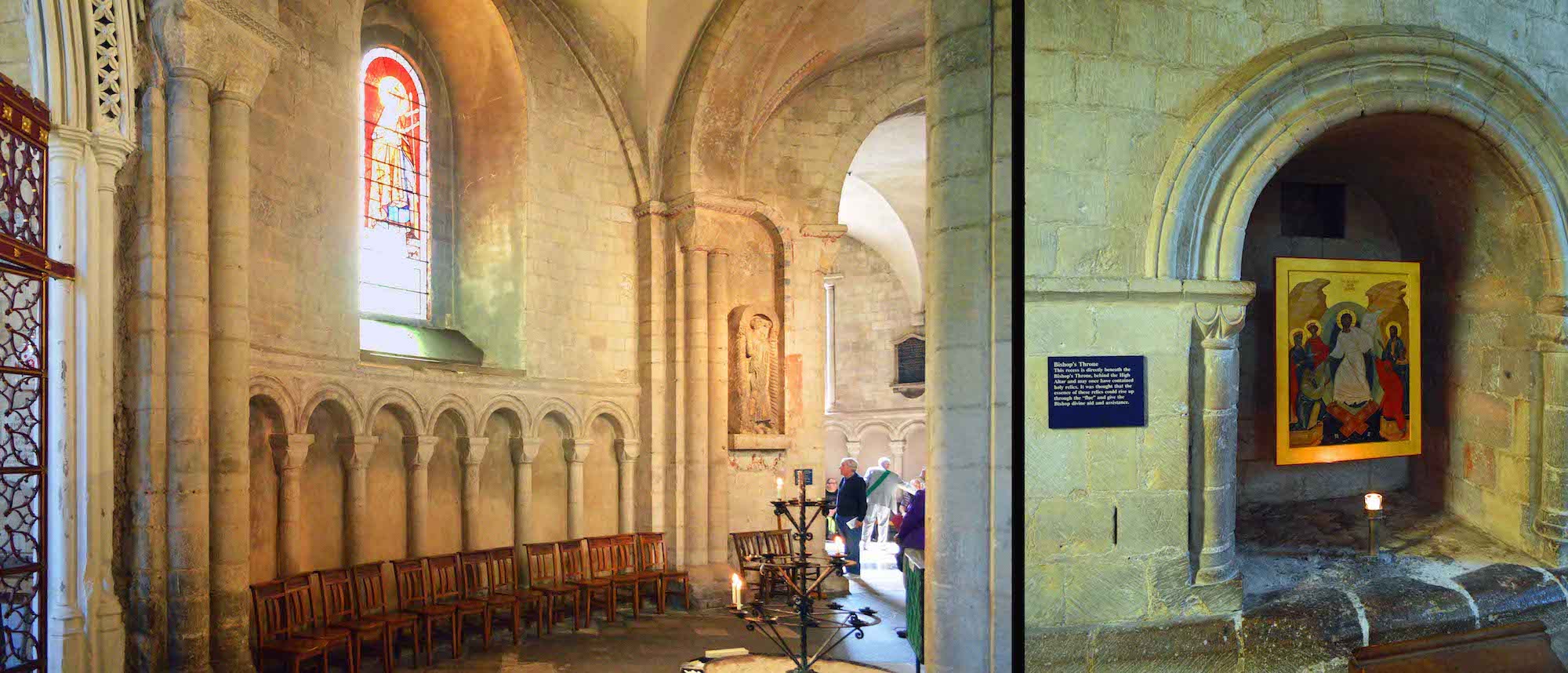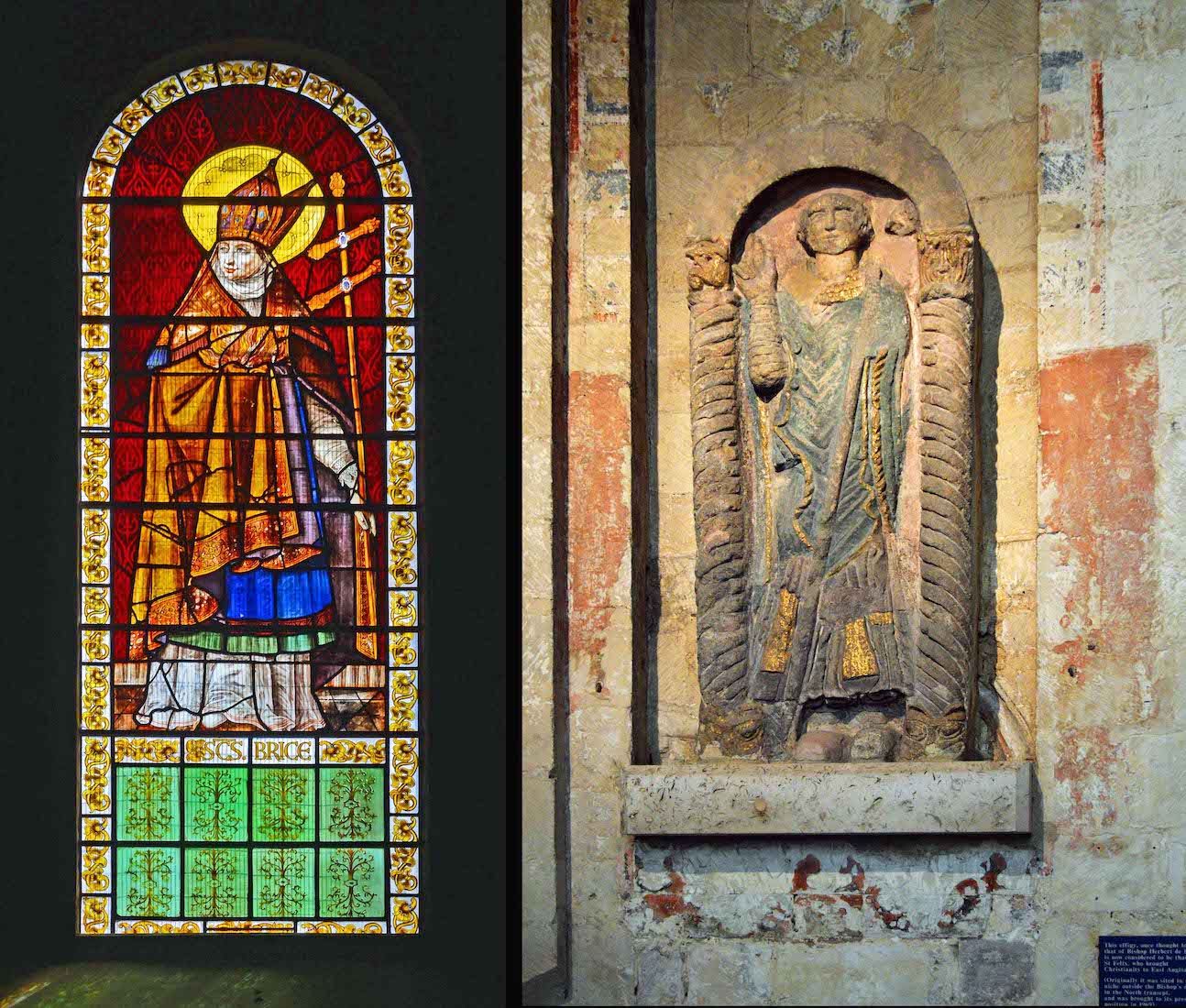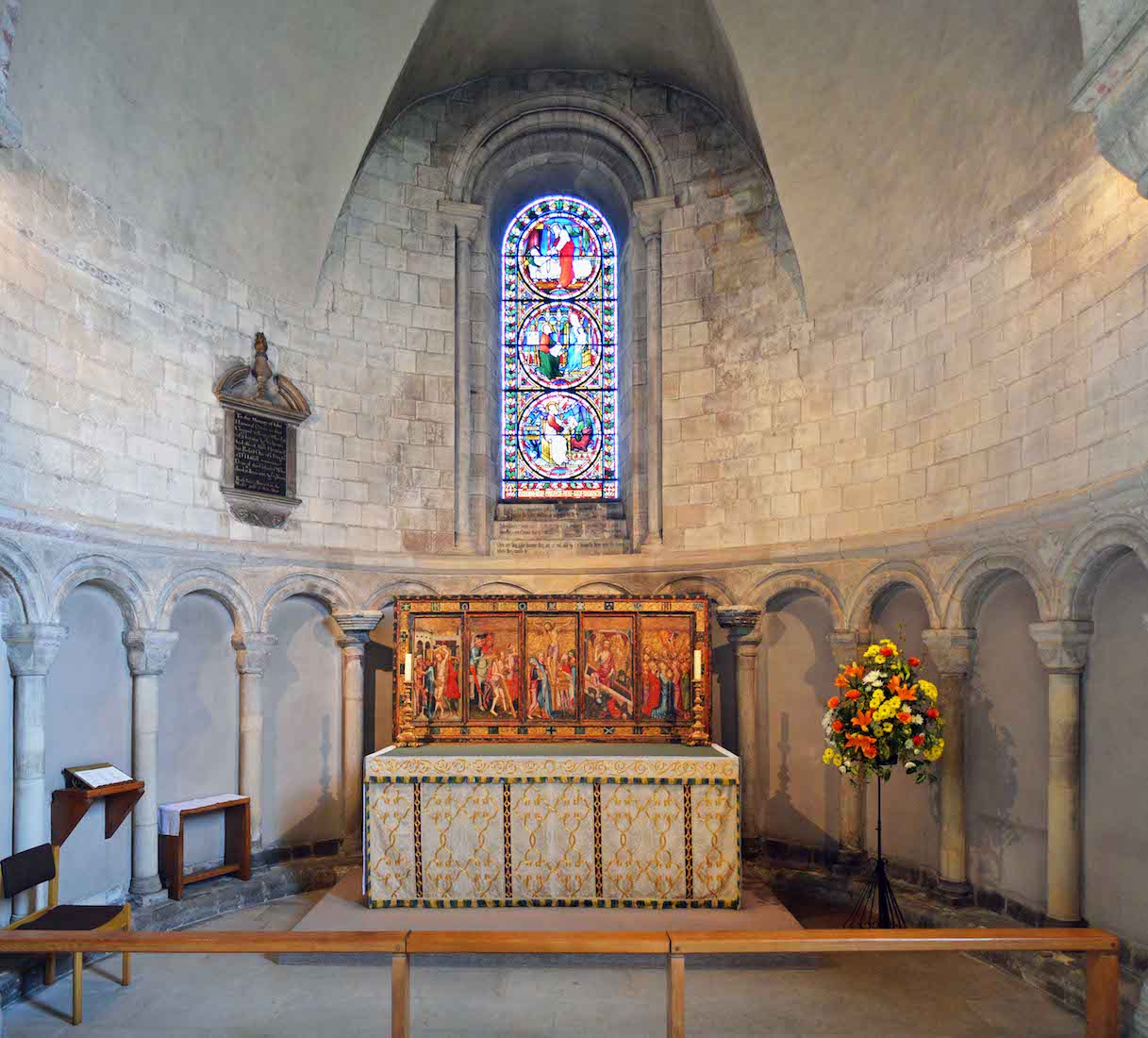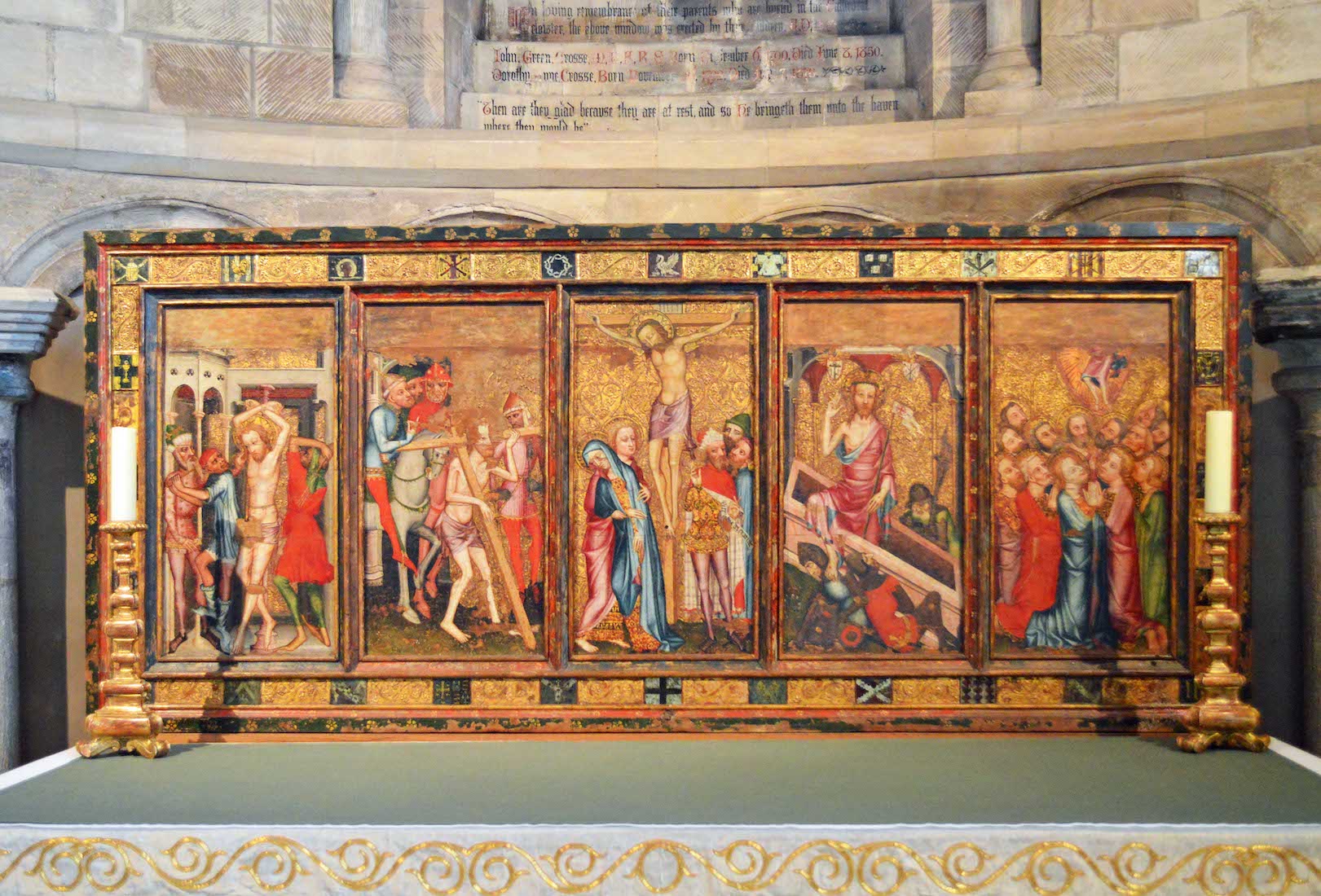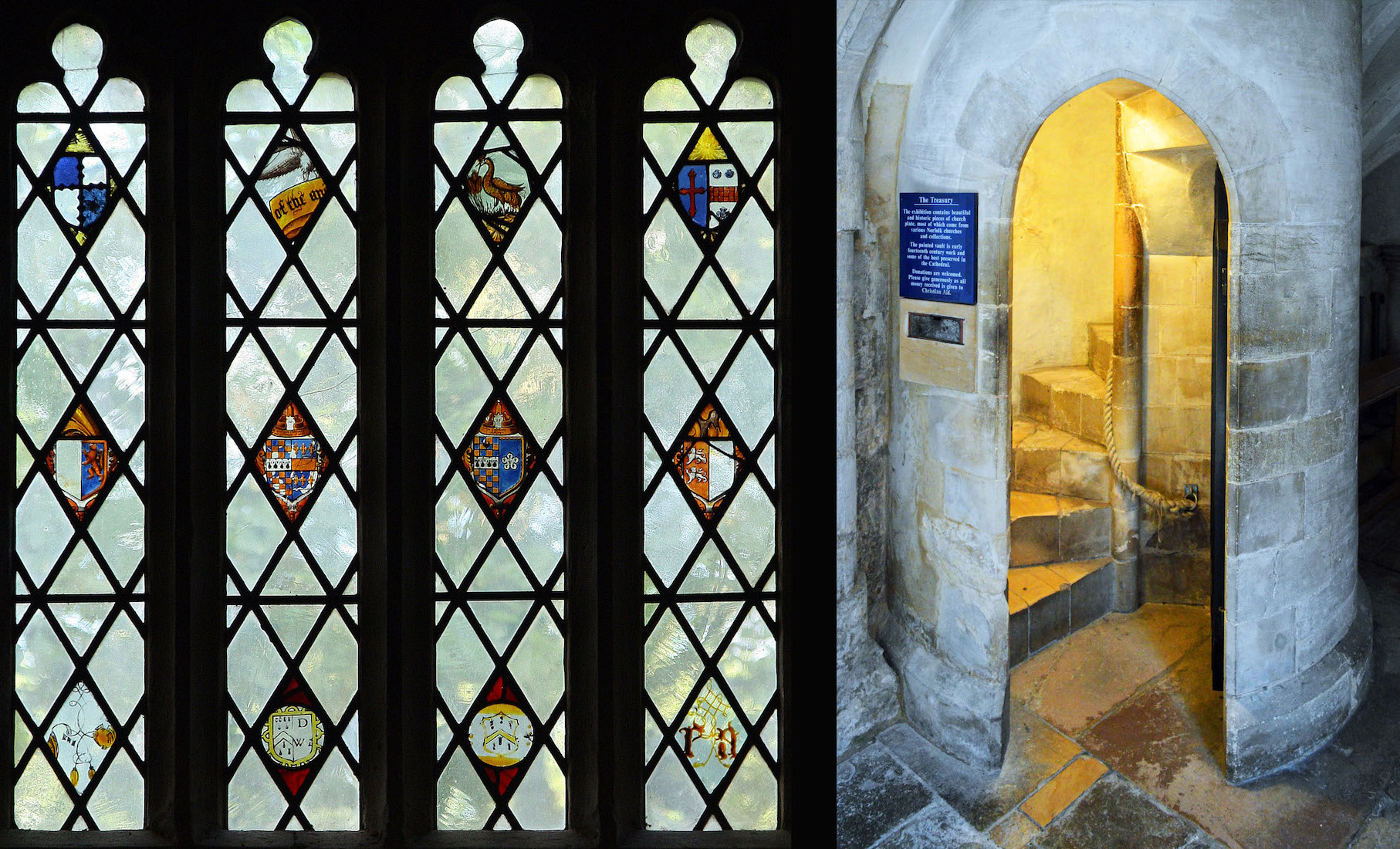
The Calthorpe Window contains a collection of twelve, mainly heraldic panels. They are the remains of 16th century glass most originally housed in the old bishop’s palace. They were arranged in this window by G King and Son in 1960, the gift of Graham Baron Ash. The two central panels are the Arms of the Calthorpe family, who owned a house near the bishop's palace gates. The two central quarries in the bottom row contain the arms of the Worshipful Company of Grocers. At right are steps up to the treasury. [Window Photo Credit: Mike Dixon] PLAN
82. CATHEDRAL TREASURES

This Treasury is a gift of the Worshipful Company of Goldsmiths, designed by Stephan Buzak RDI and opened in 1973. Churches in the Middle Ages acquired a wealth of silver vessels for celebrating Mass, and some of the Norwich collection is on display here.
83. TREASURE ON DISPLAY
The treasury has silver chalices and communion plate lent by Norfolk and Norwich parish churches and is housed in the reliquary arch, an area designed originally as a secure place for medieval treasures. The treasury is quite small, but the vessels are nicely displayed with informative cards. It is pleasing the way it is incorporated into the Cathedral building.
84. OLD FRESCO
There is some treasure of a quite different nature here too: some old fresco painting on the vaulting. The painted walls and ceiling are outstanding 14th-century work.
85. JESUS CHAPEL
We descend the stairs and continue our exploration, coming next to the Jesus Chapel. Notice the decoration on the arch and column capital. This kind of painting would once have covered all the walls of the Cathedral.
86. JESUS CHAPEL WINDOWS I
The Jesus Chapel is essentially in two parts, separated by the arch. There are four windows to examine. The c. 1868 window at left was designed by T G Jackson of J Powell & Sons. The central panel depicts the following scenes (from top to bottom): The adoration of the Magi; The presentation in the Temple; Joseph and the Angel; The Annunciation. The 1868 altar window at right was made by J Hardman & Sons specifically for this location. From left to right the main lights depict: Joseph's dream; The naming and circumcision of Jesus; The Annnunciation.
87. JESUS CHAPEL WINDOWS II
The Bacon Memorial window, second from left, was donated by the Friends of Norwich Cathedral in 1984. It is dedicated to Sir Edmund Bacon, High Steward of the cathedral from 1956 to 1970 and was collected and arranged by Dennis King (G King and Sons). The central panel contains the armorial achievement of Sir Edmund. It is a modern piece made by G King & Sons. The remaining glazing consists of reused medieval glass mainly from the church of St Andrew, Tottington, Norfolk and from Nowton Court, Suffolk. ••• The Flemish roundel of c. 1540 - 50, set in a cartouche, depicts St Peter preaching. [Photo Credits: Mike Davis]
88. JESUS CHAPEL ALTAR
The stone altar slab is a rare survival from Norman times. The painting of the Wise Men visiting the baby Jesus dates from 1510.
89. NORTH EAST AMBULATORY
Leaving the Jesus Chapel we continue walking around the ambulatory. The St Saviour’s Chapel is in sight, but there is a window on our left. The window was designed in 1951 and is made up of glass, some of which dates from 16th century. In the lower section : The top left and bottom right of the larger panels depict the arms of Francis Bacon & William Cecil Lord Burleigh. We can also see the arms of Bishop Parkhurst (1560 - 75), Dean Gardiner (1573 - 1589), and Dean Suckling (1614 - 28). [Window Photo Credt:Mike Dixon]
90. ST SAVIOUR’S CHAPEL
St Saviour's Chapel is a recent addition, having been built in 1930 as a memorial to those who died in the First World War: it is now the Regimental Chapel of the Royal Norfolk Regiment. The chapel was designed by Sir Charles Nicholson. It was built after the First World War on the site of the medieval Lady Chapel. All of the windows are similar in style and were designed by A K Nicholson in an ‘Arts & Craft’ style.
91. ST SAVIOUR’S ALTAR
The attractive altar has a central cross and the IHS and Chi-Rho symbols for Christ. The reredos behind the altar was painted by Norwich artists around 1400, and is made up of a group of painted medieval panels from the Church of St Michael-at-Plea.
92. ST SAVIOUR’S MEMORIAL STONES
There are two memorial stones in the floor here. They read: • Remember here the thirty-six officers and men of the First Battalion Royal Norfolk Regiment who died for the United Nations in Korea 1951 – 1952. •• This stone commemorates those of all ranks of the Royal Norfolk Regiment (IX Foot) who since the raising of the Regiment in 1685 have in many lands given their lives for their country.
93. ST SAVIOUR’S CHAPEL WINDOWS
East windows (the two at left): dedicated to the memory of Bernard & Mervy Coller, killed in WWI and Raymond Coller killed in WWII. The main lights depict a Nativity scene, and Christ and Mary Magdalen in the garden after the resurrection. ••• South Windows (the two at right): The main lights show St Edmund with his emblematic arrow next to Julian of Norwich, and Saint Felix and the Celtic evangelist St Fursey. Various shields and coats of arms are shown below. [Photo Credits: Mike Dixon]
94. CHAPEL WALL PANELS
These panels list various conflicts in which the Regiment has been involved, and those who have died. For example, at left: 1702 Flanders : Remember Lt-Col Bill Brinkley 1913 – 1995 : Remember those who have at any time served in the Regiment.
95. CHAPEL BOOK OF REMEMBRANCE
At the back of the Chapel is a Book of Remembrance, beautifully illustrated with illuminated pages, and listing the many names of those who have died in battle.
96. COLOURFUL TOUCHES
One of the delights of Norwich Cathedral is the many colourful insignia and coats of arms. Here we have Britannia, and the Coat of Arms of David Herbert Somerset Cranage.
97. SOUTH EAST AMBULATORY
We return to the ambulatory. Immediately on our left is a colourful window and an effigy, but on the other side, opposite the entrance to the St Saviour’s Chapel is an interesting niche containing an icon. This recess is directly beneath the Bishop’s Throne behind the High Altar and may once have contained holy relics. It was thought that the essence of these relics could rise up through the flue, and give the Bishop Divine aid and assistance.
98. AMBULATORY WINDOW AND EFFIGY
The figure in the window is St Brice who holds a cross staff in his left hand and his emblem of live coals in his right. It is Rouen glass and can be dated to c1600. This figure was spotted by Dennis King when at Langley Hall, and it came to the Cathedral in 1957. It was placed in its current location by G King and Co about 1970. The effigy is thought to be that of St Felix who brought Christianity to Norfolk in the mid 7th century.
99. ST LUKE’S CHAPEL
We have now come to St Luke’s Chapel, a chapel with apse, just like the previous Jesus Chapel. The altar has a significant reredos, and the chapel has three stained glass windows.
100. ST LUKE’S CHAPEL ALTAR PIECE
Located behind the altar in the St Luke’s Chapel is a superb painted altar piece. This was a gift to the cathedral of Bishop Despenser, given in gratitude for the failure of the 1381 Peasant's Revolt. It is among the finest pieces of late 14th century art in Europe, and depicts in five panels scenes from the Crucifixion and Resurrection of Christ.



